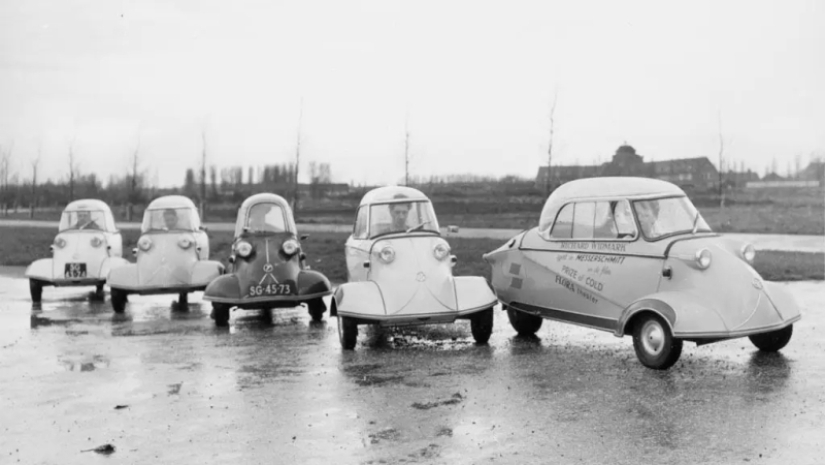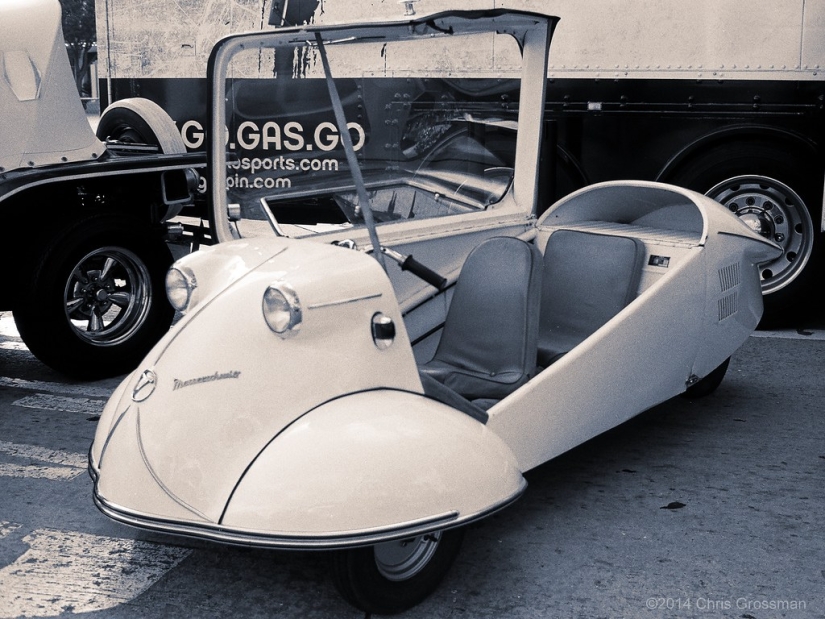The miracle of hostile technology: the Messerschmitt tricycle
Categories: Auto | History | Technology
By Pictolic https://pictolic.com/article/the-miracle-of-hostile-technology-the-messerschmitt-tricycle.htmlOver its century and a half history, the automotive industry has spawned many unusual cars. Some of them were luxurious and terribly impractical, such as the Phantom Corsair, as well as tiny and awkward, for example, Messerschmitt Kabinenroller. This funny little car, whose name can only be pronounced by the chosen one from the first time, became a descendant of the formidable Luftwaffe combat aircraft that helped the Nazis conquer the world.

The car "Messerschmitt Cabinenroller" became the most original brainchild of the German automotive industry of the post-war period. It was created in 1954 for buyers with a small income. The vehicle was a cross between a car and a motorcycle. With its outlines, it resembled the front part of the fuselage of an airplane. But that wasn't the only similarity. The car had no doors, and you could get inside by tilting the transparent aviation lantern to one side.

Messerschmitt was not a car in the full sense of the word. It belonged to the class of "cabinenrollers" motorcycle wheels. It included microlitrage vehicles, which were a closed cabin on the chassis of a scooter. These cars were produced for a very short time, but during this time they changed the second part of the name three times. Only the proud Messerschmitt remained unchanged, although the motorcycle had nothing to do with the aircraft designer Willy Messerschmitt.
The history of these babies began in 1946. After the war, there were many disabled people in Germany who decided to help engineer Fritz Fend from the city of Rosenheim. At first they were primitive strollers with foot or hand drive. But in 1948, the inventor equipped them with a small motorcycle engine. Its power was only 3 hp, but it was more than enough for a wheelchair.

Fend's motorized strollers had three wheels, with the only rear one being the leading one. Yes, the wheels were bicycle wheels, the body was single and open, and all this weighed only 175 kg. Depending on the performance of the motorcycle, the cost to buyers ranged from 800 to 1300 marks. It was quite a lifting sum even for a disabled person. Fritz Fend very quickly put the production of cars on stream, and they began to sell out like hot cakes.
In 1950, Fend decided to update the model range and created a three-wheeled scooter with a real, albeit small body. The upper part of the car reclined, providing access to two seats located one behind the other. The vehicle had only one headlight and a steering wheel, similar at the same time to the handlebars of a bicycle and the steering wheel of an airplane. Although the novelty has already cost 2000 marks, it has found its admirers.

Fend produced 250 cars, and then sat down again for the drawings. This time he designed the first real "cabinenroller". The car had a streamlined body with a plexiglass taillight and a sturdy tubular frame. There were traditionally three wheels, and the rear one was again made the leading one. However, now a more powerful 9 hp engine from the company "Fichtel und Sachs" (Fichtel & Sachs) was installed on the motorcycle. At the same time, the car was lighter than the previous model and weighed only 150 kg. If desired, it could be accelerated to an impressive 80 km/h.
While Fritz Fend's business was booming, the aviation giant Messerschmitt was struggling in agony. The companies were banned from producing any aviation products. After the bombing, only a few workshops survived, but they also stood idle. The management of the once powerful manufacturer was ready to produce anything to avoid bankruptcy. No one knows exactly how Fend and the airline found each other. But in 1953, the Regensburg Machine-Building Plant in Bavaria, belonging to the Messerschmitt company, began to produce cars with three wheels.

In the same 1953, a motorcycle with the name of the aircraft was presented at the Geneva Motor Show. The well-known brainchild of the Fend, which received a solid brand name, made a splash. The car seemed stylish and very practical to the experts. It was called Messerschmitt KR-175, that is, "Messerschmitt Cabinenroller-175". The figure indicated the engine volume in cubic centimeters.
By 1955, the next model with the index KR-200 was released. She had a 200 cc engine with a capacity of 9.7 hp. All engines of the line were motorcycle engines and ran on a mixture of gasoline and engine oil. The upgraded car already weighed 240 kg, but it developed a crazy speed of 100 km/h for its class. The maximum gasoline consumption was 3-3.5 liters per 100 km.

For advertising purposes, even a sports version of the Messerschmitt was assembled at the factory in Regensburg. In the races, she showed a speed of 140 km /h! But even without advertising, the demand for cars was huge. In 1955-56, the plant produced 50 motorcycle wheels per day. They sold well in Germany and were exported to other countries. Unfortunately, it all ended in 1956. Messerschmitt was allowed to build planes again. Of course, the funny motorcycle wheels that allowed the company to survive difficult times were discontinued.
Recent articles

Dangerous products for humans can not always be distinguished by their appearance and even taste. "Drunk" honey looks like ordinary ...

In the middle Ages cats suffered a great deal from Catholics. They were burned and tortured, thrown behind bars and into the fire, ...

Children are not toys, but some babies look a lot like their dolls. Just like twins! Which child do you think is most like their toy?